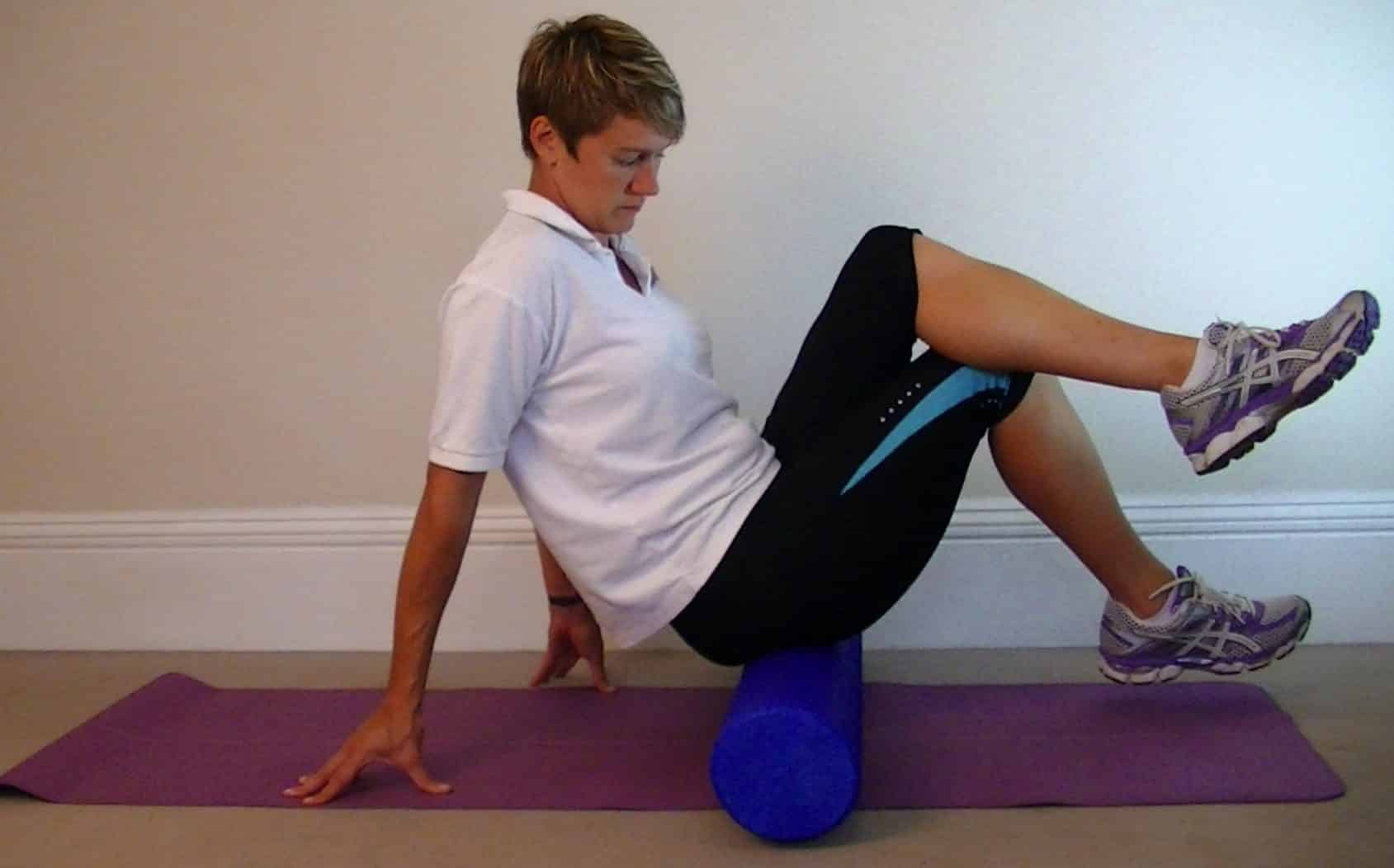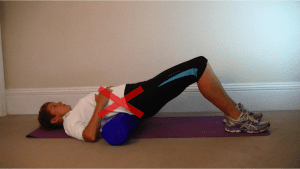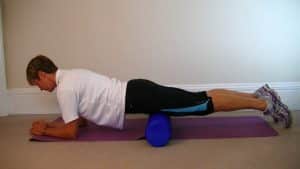
- Basic Foam Roller principles for safe and effective use,
- Things to avoid when doing self-massage,
- Some different ways you can use a foam roller,
By the end you should be much clearer about the best use of your foam roller and maybe have a few new ideas of how you can incorporate it into the rest of your fitness regime.
Basic Principles of Foam Rolling for self-massage
Often people can be unsure where to begin with foam rolling, which bodies areas to use it on. Then there’s the question of how to perform the technique. Firstly lets deal with where to use it. Ultimately you can self massage almost every muscle in the body, the foam roller may not be the best tool for the job in some areas though!
The best place to start are the muscles you know your need more flexibility in, possibly because the exercise you do requires a greater range of movement in a joint to improve performance, or because you have been advised to lengthen certain muscles. Think of common postures you find yourself in and what muscles will be shortened by that position. For example, if you have an office job and spend a lot of time sitting either at work or driving there and back, you are likely to be tight in your hamstrings and hips flexor muscles.
You can also get an idea of muscles that may benefit from foam rolling because you have felt tightness or a pulling in a certain muscle during sport or exercise. Maybe you have noticed one muscle is tighter than another when you have been stretching or doing yoga. Once you begin to self-massage you will then become aware of tender spots within the muscle you are working on. These are tight areas or knots within the muscle. A trigger spot is a tension area that also then sends referred pain to other surrounding areas. Such areas highlight that you need to work gently on those trigger points and on the surrounding tissues and muscles to help release the tension.
How to use a foam roller for self massage: Here are the basic principles and rules to safe and effective self-massage with a foam roller: 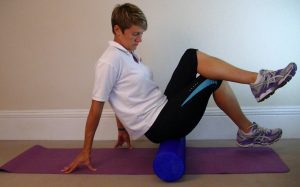
2 – Slowly roll over the foam roller, gradually working along the whole length of the muscle. If you go to fast it is likely to be more painful. Rushing over the tight spots doesn’t give your brain time to process what is happening and allow the muscle to let go and relax. By going gently and slowly you will become a lot more aware for where the tension areas are. You are also allowing the different layers of tissue time to react to the pressure and respond. Take you time over tender areas using short, slow movements. This is not a exercise in beating up your muscles into defeat and seeing how much pain you can tolerate!
3 – As mentioned before tender areas indicate tight regions within the muscles. It will feel uncomfortable, in the same way a stretch does initially, but it should not be painful and unbearable. If an area is tender and uncomfortable, pause on that spot for 10-30 seconds. That is equivalent to applying a local stretch to the muscle fibres there. You should notice the muscle relax after that time and you can move onto the next area.
****If you hold the pressure too long you may do more harm than good causing more damage to the tissues or be putting pressure on a nerve. You can always moderate the amount of pressure you apply by altering the amount of body weight you rest onto the roller.
4 – If an area is too painful, use that as a guide to tell you to work away from that spot onto the surrounding tissues or even connecting muscles first. Remember pain and tension can be a result of imbalances in other muscles which in turn put excessive strain elsewhere.
If you are wanting to massage the IT-Band along the outside of your leg, but it is too painful, it may be you need to work into the hip flexors (particularly the Tensor Fascia Latae which is the top outside of your thigh) and Gluteus Maximus (your bum muscle) first as these become the IT band and so releasing these muscles make result in the tension going out of the IT band naturally.
Take your time to work the area around a painful spot first and allow the body to respond to that before tackling it head on. You may find you don’t need to in the end.
5 – Watch you posture, as with any exercise how you do it is more important that what you are doing. If you are not sure how to massage a particular muscle, get someone to talk you through it and check you are keeping you body in the correct position.
Some muscle groups require you to support the rest of your body weight on your hands and if you are unable to do that properly you will be creating tension and imbalances elsewhere. This can lead to emphasising the poor postures you are trying to correct or lead to other issues or injuries. It is worth foam rolling in front of a mirror so you can check your whole body alignment and positioning. If this isn’t possible try recording yourself on your phone so you can see what you are doing rather then trying to guess by how it feels.
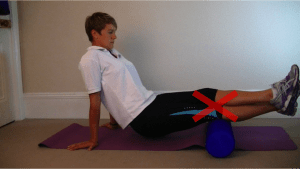 6 – Never use a foam roller to massage joints . The foam roller is curved and so putting pressure through a joint over the curved structure may strain the joint into a position it is not meant to go into. This can overstretch or strain the ligaments supporting the joint and put you at great risk of injury. Additionally you do not need to massage joints, only the muscles that move the joints, the body will do the rest.
6 – Never use a foam roller to massage joints . The foam roller is curved and so putting pressure through a joint over the curved structure may strain the joint into a position it is not meant to go into. This can overstretch or strain the ligaments supporting the joint and put you at great risk of injury. Additionally you do not need to massage joints, only the muscles that move the joints, the body will do the rest.
7 – Avoid using the foam roller on your lower back. You can of course us it to massage the upper and mid back but only as far down as the base of the ribs. After this you are asking the body to balance on the vertebrae of the spinal column which is likely to cause the supporting surrounding muscles to activate rather than relax and they work to protect the lower back. You are much better of working on the muscles that effect and connect to the back, such at the gluteals and piriformis muslcle, the hamstrings, quadriceps and hip flexors. It is often a muscle imbalance between these muscles that puts strain onto the lower back.
As with any exercise, whilst you may not think you have done a workout, your muscles and connective tissues have been worked. SO in the same way, you may feel a little sore or achy the next day, as you would after a gym session, but it should not last longer than that. If you are still sore more than 24hrs later that is your body letting you know you did a little too much. It may be that you used too much pressure, worked over the tight areas too long, or did not go slow enough to allow the tissues to respond.
To maximise the benefit and minimise the soreness, be sure to drink plenty of water, eat a good nutritious meal and get a good nights sleep. This will help the healing and restoration of the tissues and maximise the elimination of waste products from the muscles.
If you think carefully first what it is you are trying to achieve through foam rolling and stick to these principles you will reap the benefits. Remember, as with any change it will take time and repetition is the key here. Get into the habit of making this part of your exercise regime and you will notice the changes.
If there are any areas you are not sure about then seek advice from a healthcare professional first. Areas such as the neck and lower back may need more precise and specific attention best done by a trained therapist. Integrating self-massage into your exercise plan is a great way, along side stretching, to maintain the health of your muscles and connective tissues. It enhances recovery from exercise and acts like a maintenance massage, however it is worth getting treatment or a massage from a qualified therapist intermittently as there will be some areas you may not be able to release effectively on your own. They can also keep an eye on any imbalances or postural habits you may not have noticed.
Other uses for a foam roller: Whilst the foam roller is fantastic for self-massage there are other ways you can use it to work alongside your other sport and exercise choices and keep things varied. 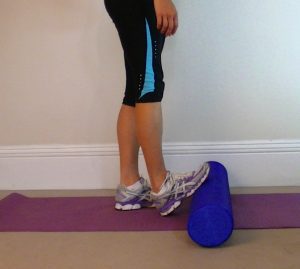
Just as a swiss/exercise ball can be used as a stretching aid, so can a foam roller. Lying over it lengthways and widthways can provide a great stretch to the back and open up the chest.
Rolling the foot over the curved surface can provide an excellent stretch of the calf muscles. Also on your front sitting down onto you heels, you can roll the foam roller out to the side with your arm to stretch the chest. It can help enhance a hip flexor stretch and really open up the lats.
The curve and wobbly nature of a foam roller also makes it a handy piece of equipment for pilates or core conditioning work. Due to the shape of the roller it can change static or single plane exercises into ones that challenge to body in 2 planes of motions. They can be used for balance work, improving body awareness and dynamic strength work alongside the stretching and muscle release functions. 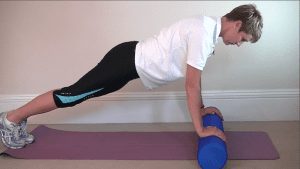
For example : you can lie on it length ways whilst doing arm exercises, giving an additional balance element to the challenge. Bridging exercises can be done with one or both feet on the roller to again reduce stability. Alternatively place your hands on the roller instead of the floor when doing exercises such as the plank or press-ups. You don’t just have to lie on it either.
How about standing on it whilst using dumbbells. I would suggest getting a half or D roller, with a flat side and a curved side, to start working this way. Beginning by placing the half roller flat side down, you can use the curved side to balance on but still maintaining a stable surface. Then you can turn it the other way up so you stand on the flat side and the curve gives a more unstable surface to work off. Once you have good balance on that you can try standing on the full foam roller, this will really test your stability and balance.
With a little imagination there are loads of ways you can make use of a foam roller as part of your exercise and fitness package. I hope this has helped to clear the fog about foam rollers and given you lots of ideas of how to use one.

